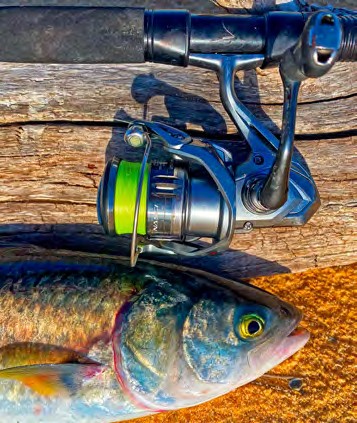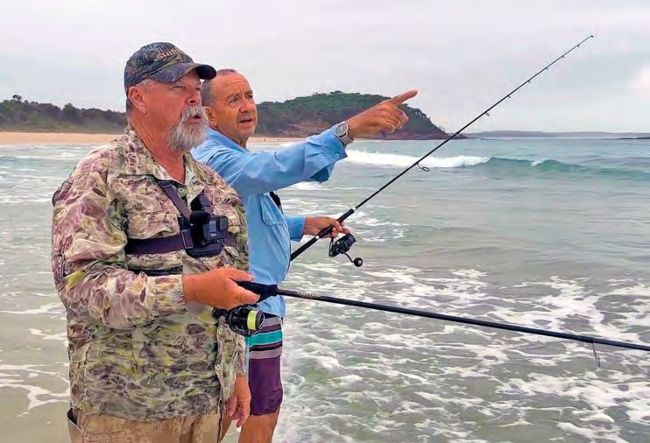TRY GOING A BIT LIGHTER IN THE SURF!
Starlo reckons it can really pay dividends to “lighten up” on the beach…
Beach or surf fishing is one of the most popular forms of land-based angling right around the southern half of Australia, and it’s not hard to see why. We’re blessed with some great beaches, and they all hold fish.
For me, one of the attractions of beach fishing is its simplicity. You don’t need a mountain of expensive tackle. Better still, if you live close to the coast (as a lot of us do), beach fishing lends itself to unplanned, spur-of-themoment trips. If the conditions seem right and you have a break from work or household chores, you can simply grab your gear and go! However, in my experience, choosing the right tackle makes a big difference to both your chances of success, and your overall enjoyment of the process.
Practical surf rods are generally quite long: anything from three to four metres (9 to 13 feet on the old scale). This length really helps with casting, and is also useful for keeping your line up above any annoying surge and drag from the shore break. Yes, you can get by with shorter rods, especially on calm days, but a bit of length is very handy a lot of the time.
But it’s worth remembering that longer rods don’t necessarily need to be heavier rods, especially in this era of space-age materials such as graphite composites. I reckon there’s a lot to be said for going a little bit lighter with your beach fishing outfits.
The single biggest mistake I see surf casters making right around the country is burdening themselves with ridiculously heavy gear. Let’s face it, most of fish we hook in the surf weigh a few kilos or less… often considerably less! Sure, we all live in hope of pinning a man-sized mulloway or a serious shark to really test our tackle. But in reality, these prizes are few and far between, and they often fall to specialists anglers fishing with big baits after dark, or prospecting along our more remote stretches of coastline.

Australian salmon are wonderful on light surf tackle
If you’re seriously targeting the big stuff, by all means beef up your gear accordingly. But if you’re primarily chasing the more typical run of fish that dominate our surf breaks, for goodness sake, lighten up! If you do, I absolutely guarantee that you’ll catch more fish, and have a heap more fun doing it. And if your number comes up for the jackpot and you happen to hook that fish of a lifetime, you’re still very much in the running to land it, especially given some time, a bit of patience, and a cool head.
The average surf-casting outfit I see in the hands of most beach fishing hopefuls often resembles a telephone pole, typically fitted with a 6000 to 10,000 size spinning reel full of 10 or 15 kilo line. Because this overweight tackle is so incredibly cumbersome, those using it tend to heave their big sinkers and baits as far as out as possible, then stagger up the beach to their rod holder and drop the outfit into it before flopping down onto the sand to wait and watch expectantly for the white-painted tip of their towering telephone pole to finally signal a bite. Sadly, what they mostly end up catching is clumps of drifting kelp.

I take a very different approach to my surf fishing by choosing the lightest, most sensitive three to four metre rod I can find (usually one with a fair proportion of graphite in its blank) and matching it with a 2500 to 4000 size spinning reel. My main line is four or five kilo braid (although mono is fine), and I knot a rod-length leader of six or eight kilo nylon or fluorocarbon to the end of the braid before attaching my rig.
If I’m lure casting, my metal slice, baitfish profile or jig-rigged soft plastic goes directly onto the end of this leader. When I’m bait fishing, a modest ball or bean sinker (usually just 15 to 30 grams in weight) runs freely on the long leader, separated from a small swivel by a plastic bead to prevent knot damage when casting. Below the swivel I can attach a half-metre or so hook link of fluorocarbon of a strength suited to the task at hand, with a hook or hooks tied to the end.
Because my outfit is so light, I don’t drop it in a holder and wait for bites. Instead, I keep the gear in my hands and walk along the sand with any drift, to stay in touch with my moving bait. Bites are transmitted readily via the lighter gear (especially when I’m running low-stretch braided line) and a lot more fish are hooked as a result. When they are, they give a great account of themselves on the finer tackle, especially when they’re not dragging half a house brick of sinker behind them!
Most fish need to be deftly played on this light gear, and they can’t be simply hauled or dragged up the sand against a powerful backwash. Doing so will usually tear out hooks or even snap leader knots. Instead, you’ll need to learn to make use of the breaking surf to wash your catch ashore, gaining line as a wave surges up and then quickly yielding it as the water retreats. It keeps you on your toes and, in the process, makes you a much better angler!
One more important tip: modern, sophisticated reels with gears and other moving parts don’t like sand! Never hit the beach without carrying a metre-long section of PVC pipe. Push this deep into the sand and stand your rod and reel in it every time you bait up, re-rig or need to put the outfit down. Trust me, your reels will last many years longer as a result.
For me there’s nothing quite like clean sand crunching between my toes and the tang of salt in my nostrils as I belt a bait or lure out over the surf break with my light, responsive outfit. Catching a fish is almost a bonus… almost!

‘Working out’ the beach is very important